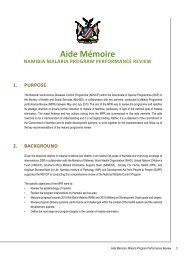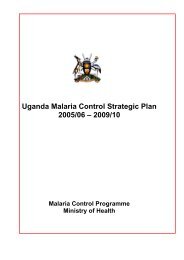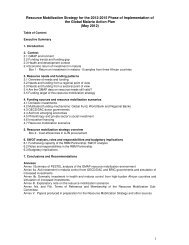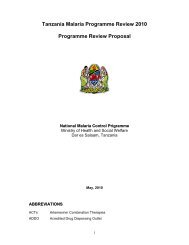Progress & ImPact serIes - Roll Back Malaria - World Health ...
Progress & ImPact serIes - Roll Back Malaria - World Health ...
Progress & ImPact serIes - Roll Back Malaria - World Health ...
Create successful ePaper yourself
Turn your PDF publications into a flip-book with our unique Google optimized e-Paper software.
executive summAry<br />
executIve summary<br />
In recent years, the expansion of malaria<br />
prevention tools and a scale-up of diagnostic<br />
testing and treatment has led to significant<br />
progress against the disease in countries outside<br />
of Africa. Yet, this mosquito-borne disease<br />
continues to impose a major burden on national<br />
health systems, requiring tailored control<br />
strategies for different geographical areas within<br />
countries. The 51 malaria-endemic countries<br />
outside of Africa had an estimated 34 million<br />
malaria cases in 2010 and approximately<br />
46 000 related deaths. a This report focuses<br />
on countries in Asia, the Pacific, Americas,<br />
Middle East, and Europe because of their unique<br />
circumstance; many countries are on the brink<br />
of eliminating malaria while at the same time<br />
facing challenges that aren’t seen elsewhere in<br />
the malaria-endemic world.<br />
The level of malaria risk in these regions can<br />
vary enormously. It can be as high as in parts<br />
of sub-Saharan Africa, with cases and deaths<br />
concentrated in children under five years of age,<br />
or 1000-fold lower where cases and deaths occur<br />
according to the degree of exposure. <strong>Malaria</strong>’s<br />
main victims tend to be poorer populations<br />
living in rural communities, with limited or no<br />
access to long-lasting insecticidal nets (LLINs)<br />
and artemisinin-based combination therapies<br />
(ACTs). Despite being entirely preventable and<br />
treatable, malaria exacts a tragic human toll<br />
on societies while its economic and social<br />
impact is also devastating. Not only is it<br />
disproportionately concentrated in poor and<br />
vulnerable communities, it has been a major<br />
barrier to economic development, tourism, and<br />
foreign investment.<br />
While the disease burden has been declining in<br />
countries with fewer malaria cases and deaths,<br />
progress has been slower in countries where the<br />
bulk of the disease burden lies: India, Indonesia,<br />
Myanmar, Pakistan, and Papua New Guinea.<br />
These five high-burden countries account for<br />
89% of all malaria cases in the region and need<br />
substantial financial resources and technical<br />
assistance to strengthen their health systems<br />
before they can visibly improve their malaria<br />
response. At their current pace, it is unlikely that<br />
these countries can achieve the malaria-specific<br />
Millennium Development Goals and the <strong>World</strong><br />
<strong>Health</strong> Assembly target of reducing the malaria<br />
burden by at least 75% by 2015.<br />
The fight against malaria is further complicated<br />
by growing parasite resistance to antimalarial<br />
drugs. In recent years, artemisinin resistance<br />
in the Greater Mekong subregion has become<br />
a major and urgent concern. There is a limited<br />
window of opportunity to contain resistant<br />
parasites before they spread around the world.<br />
To avert a regional public health disaster with<br />
a The uncertainty range for malaria cases outside of Africa is 32 to 45 million, while for malaria deaths it is 42 000 to 70 000.<br />
DEFEATING MALARIA IN ASIA, THE PACIFIC, AMERICAS, MIDDLE EAST AND EuROPE<br />
7











